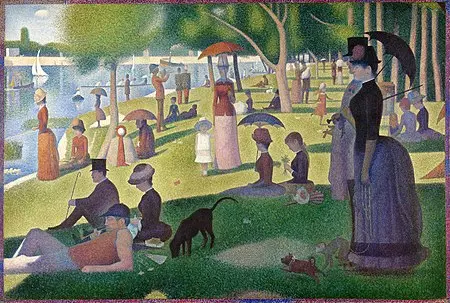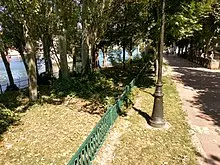 Georges Seurat, Study for "A Sunday Afternoon on La Grande Jatte", 1884, oil on canvas, Metropolitan Museum of Art, New York
Georges Seurat, Study for "A Sunday Afternoon on La Grande Jatte", 1884, oil on canvas, Metropolitan Museum of Art, New York
A Sunday Afternoon on the Island of La Grande Jatte is Georges Seurat's most famous masterpiece. Painted between 1884 and 1886, it captured the essence of the neo-impressionist movement. The painting, which showcases Seurat's pointillist technique, features Parisians enjoying a leisurely day at a park on the banks of the River Seine. Today, it is housed in the esteemed Art Institute of Chicago.
Exploring the Background
 Georges Seurat, Study for "A Sunday Afternoon on La Grande Jatte", 1884, oil on canvas, Metropolitan Museum of Art, New York
Georges Seurat, Study for "A Sunday Afternoon on La Grande Jatte", 1884, oil on canvas, Metropolitan Museum of Art, New York
Seurat devoted his time and attention to perfecting the landscape of the park in A Sunday Afternoon. From May 1884 to March 1885, and again from October 1885 to May 1886, he meticulously focused on color, light, and form. The painting, measuring approximately 2 by 3 meters, is a result of Seurat's numerous preliminary drawings and oil sketches. It is displayed at the Metropolitan Museum.
Inspired by the optical effects and color theories of Michel Eugène Chevreul and Ogden Rood, Seurat incorporated scientific research into his artwork. He employed miniature dots and small brushstrokes of contrasting colors, which, when viewed together, formed a single shade or hue in the viewer's eye. This technique, known as Divisionism or Pointillism, added brilliance and depth to the painting. To enhance the experience, Seurat surrounded the artwork with a frame of painted dots, enclosed within a pure white wooden frame as exhibited in the Art Institute of Chicago.

La Grande Jatte, situated on the banks of the River Seine between Neuilly and Levallois-Perret, was once an industrial site but now serves as a public garden and housing development. Seurat began painting the scene in 1884 when the island was a serene retreat away from the bustling city.
Unveiling Interpretations

A closer look at A Sunday Afternoon reveals distinctive features. In contrast to his earlier work, Bathers at Asnières, which bathes its subjects in light, La Grande Jatte depicts almost every figure cast in shadows. Parisians sought solace from the summer heat under the shade of trees and riverside breezes. The painting showcases a variety of people partaking in leisure activities. From a fashionable couple on a stroll to a woman fishing and a man playing a trumpet, the park exudes life and diversity. Seurat also included peculiar elements, such as a lady with a pet monkey on a leash and a woman silently questioning the viewer.
Throughout the years, Seurat's masterpiece has garnered different interpretations. Historian and philosopher Ernst Bloch believed that the static nature of the figures reflected the societal norms of the time. Others have criticized Seurat's mathematical approach to capturing the essence of modernity in Paris. Nevertheless, the painting continues to captivate viewers and spark conversations about art and society.

According to Seurat, the Panathenaic procession in the Parthenon frieze served as his creative inspiration. Through his artwork, he aimed to portray ordinary people and their everyday lives, as well as the harmony of opposing elements such as urban and rural, bourgeois and proletarian. The inverted color border surrounding the painting suggests a gradual inversion of the world surrounding the subjects, as if their way of life is slowly changing. Seurat's masterpiece, with its intricate details and thought-provoking elements, continues to resonate with audiences.
Mastering the Materials
Seurat's artistic journey in creating La Grande Jatte can be divided into three stages. In the first stage, which began in 1884, he used various pigments, including earth tones like ochre and burnt sienna. In the second stage, between 1885 and 1886, Seurat advanced his palette by incorporating fewer pigments and adhering to the color theories of the time. He aimed to create small dots or strokes of pure color that would blend on the viewer's retina to produce the desired color impression. His palette consisted of cobalt blue, emerald green, vermilion, and the new pigment zinc yellow, which he used for sunlit grass. Over time, the zinc yellow has darkened, resulting in a brownish hue. In the third stage, Seurat added colored borders to his composition, creating the final masterpiece.
The Art Institute of Chicago's Acquisition

In 1924, the Art Institute of Chicago acquired A Sunday Afternoon on the Island of La Grande Jatte. Trustees Frederic and Helen Birch Bartlett, avid collectors of French Post-Impressionist and Modernist art, purchased the renowned painting. It was a significant addition to the museum's collection, which was influenced by Mrs. Bartlett's passion for avant-garde artists.
Immortalized in Popular Culture
The painting's charm and relevance have extended beyond the art world. A Sunday Afternoon on the Island of La Grande Jatte served as the inspiration for the 1984 Broadway musical, Sunday in the Park with George, which narrates a fictionalized account of its creation. Additionally, the painting has made appearances in films like Ferris Bueller's Day Off, Looney Tunes: Back in Action, Family Guy, and Muppet Babies. The artwork has even been recreated as a topiary installation in Topiary Park in Columbus, Ohio.
Georges Seurat's A Sunday Afternoon on the Island of La Grande Jatte continues to captivate art enthusiasts and ignite discussions about its historical and artistic significance. Its meticulous composition, innovative use of color, and intriguing narrative make it a timeless masterpiece that leaves an indelible mark on the art world.
















